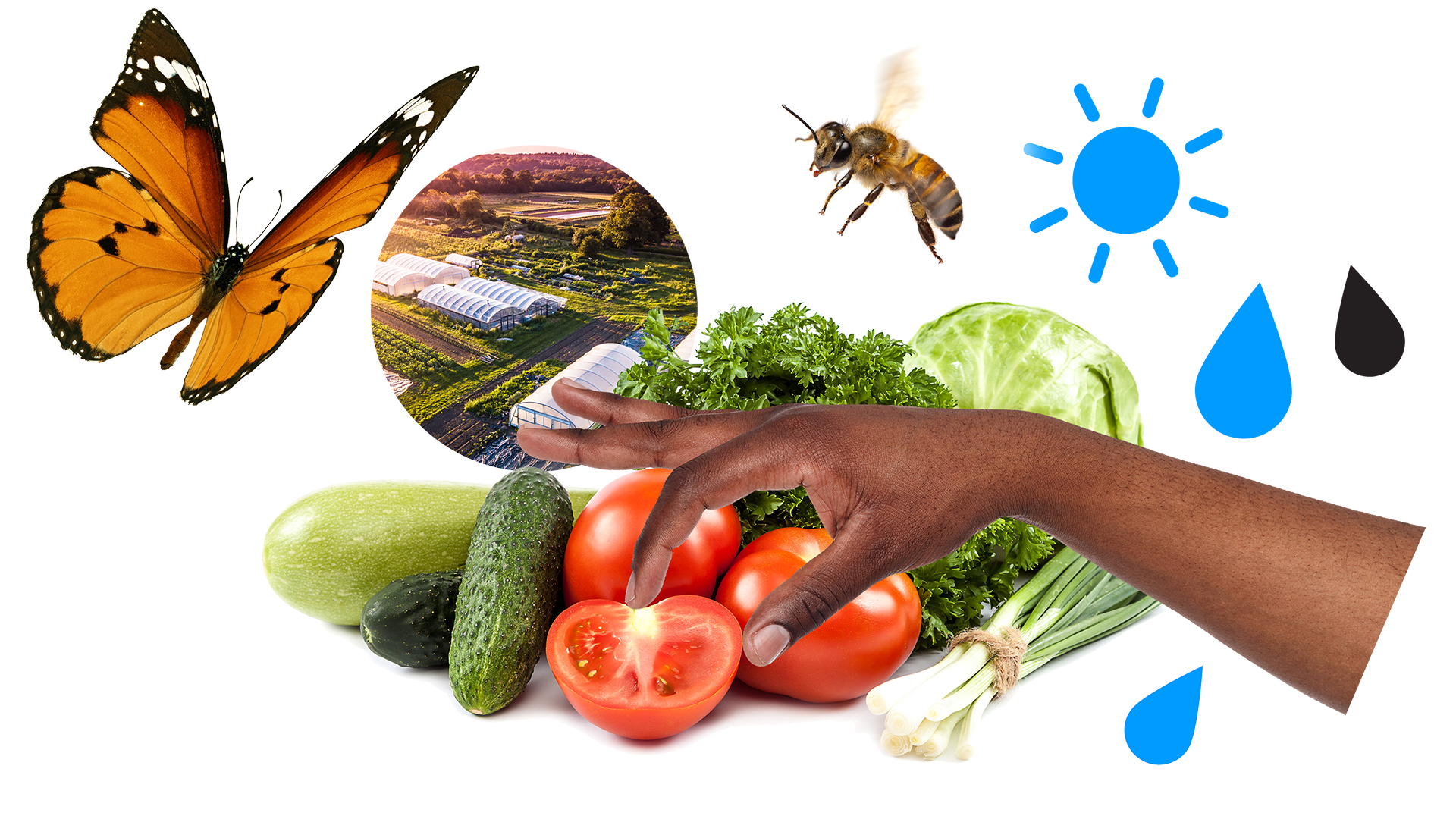
Group D03: The Nudgers/ Tuuppijat
Object: We want to nudge people to choose a plant-based (protein) option more often than they currently do, for example in a lunch restaurant or in a food app. This would lead to a reduction in eating meat and an increase in eating healthier vegetables. This is something to strive for as meat production has considerable environmental effects, and more plant-based foods would also improve our health. We encourage catering sector to increase availability of plant-based options, to use locally produced plant ingredients and to connect with local food producers.
Short description: A nudge is “any aspect of the choice architecture that alters people’s behavior in a predictable way without forbidding any options or significantly changing their economic incentives” (10). Nudging is a quite new concept based on Behavioral Economic theory which has been developing since the early 1970s, but the term ‘‘nudging” was only invented for the first time by Thaler and Sunstein in 2008 (11).
Although habits are difficult to change, they are also influenced by what is happening around us, which information is often processed outside of conscious awareness. Hence, by changing the environment where dietary choices are made, can dietary behavior be altered (11). Nudging also does not enforce any restrictions, but lets the customer have the freedom of choice (12). Nudging can be done through simple interventions and opt-in systems in which people can make positive choices (13). The
concept covers multiple approaches to alter social or physical environments to make certain behaviors more likely (13).
Plant-based and healthier diet takes environmental (e.g., smaller carbon and water footprint), social (healthy diet) and economic (healthier, but not more expensive) aspects into consideration. Increasing use of locally produced plant proteins enables better connectivity between catering sector and consumers with local farmers.
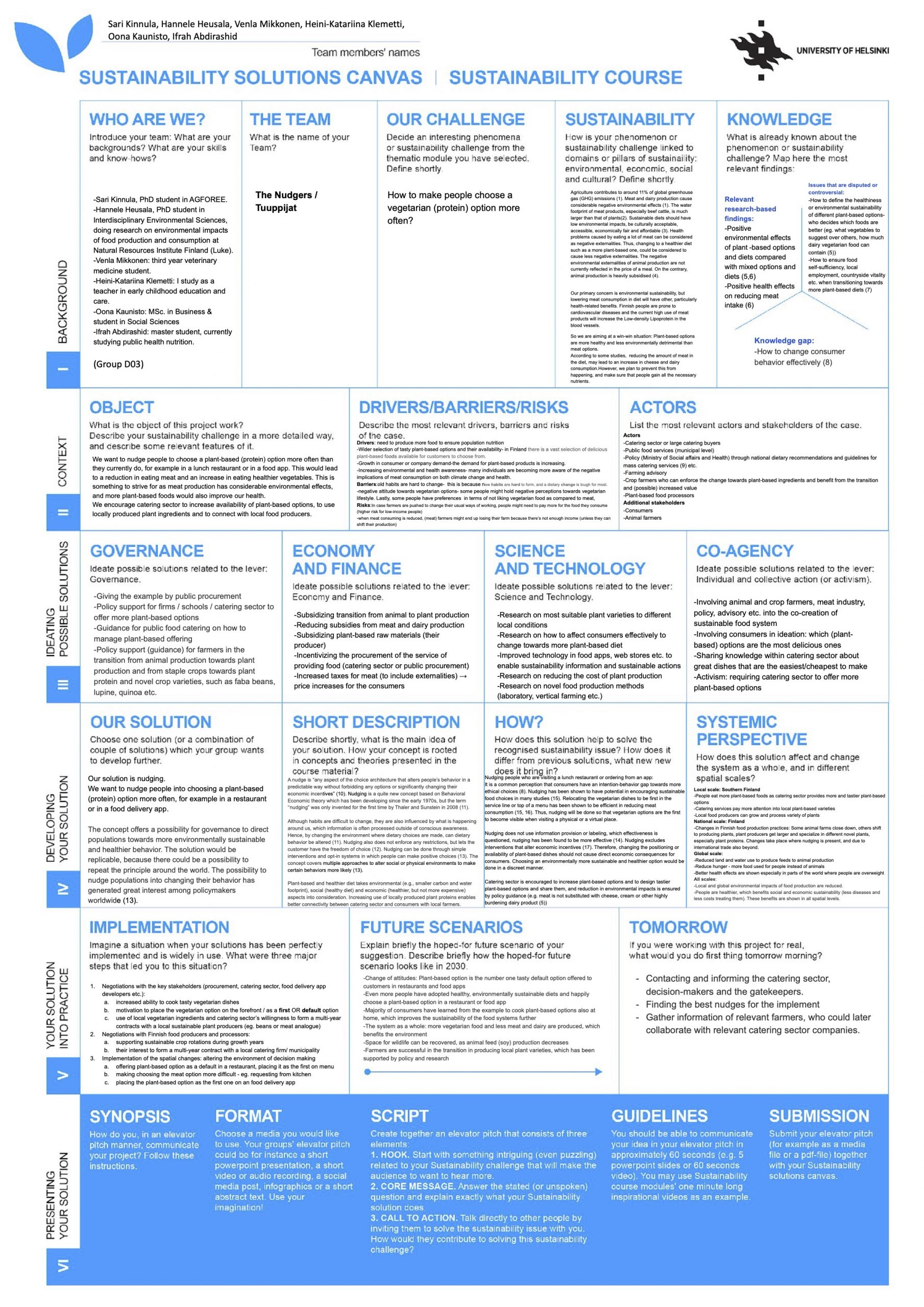
(click canvas to enlarge)
Elevator Pitch:
Meat and dairy industry is responsible for 15% of man-made greenhouse gas emissions and takes up to 77 % of the agricultural land in the world. Finnish consumers say that they are eager to reduce meat consumption, but at the same time the amount of meat eaten per person has been staying the same. Changing behavior is difficult – but altering the options by nudging is much easier! We want to influence catering companies and food apps to increase the plant-based options and place them as the first option for a consumer to pick. Just changing the selection from which people can choose will have a massive influence on the population scale! We invite you to help people use less effort to make sustainable decisions. Request decision makers, businesses and restaurants to increase plant-based options and place them as the default one!
Group D05 : Luomu Life
Object: Food wasted by consumers contributes to many sustainability issues. This food waste is preventable and often happens due to laziness, forgetfulness or lack of information. The purpose of the app is to provide the consumer with different tips and tricks on how to avoid food waste and to get them interested in other topics relating to food and sustainability.
Short description: A free downloadable app that helps consumers to make sound, well-informed decisions about what foods and how much food to buy, how to store it and prevent it from spoiling and how to best dispose of food waste.
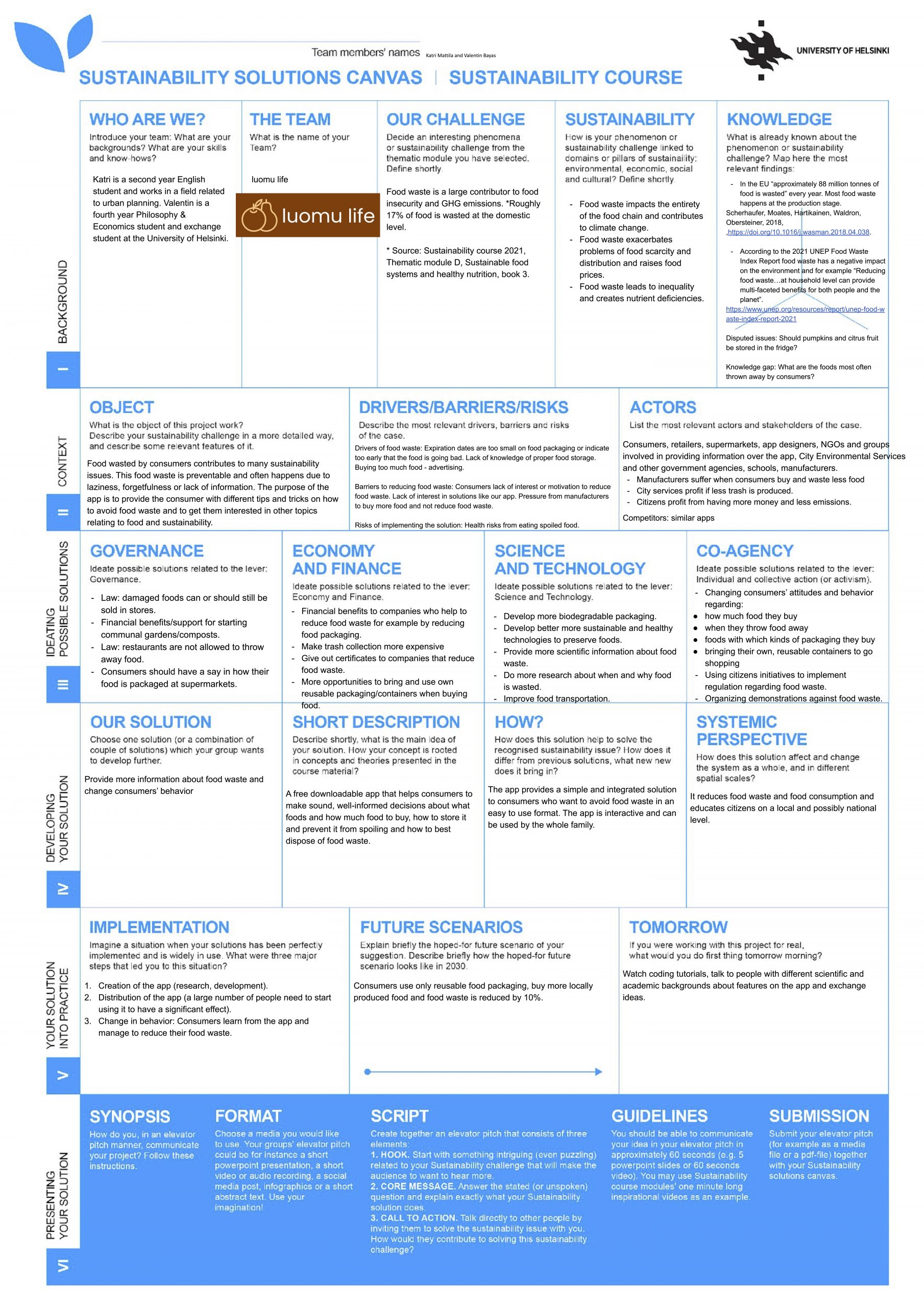
(click canvas to enlarge)
Elevator Pitch:
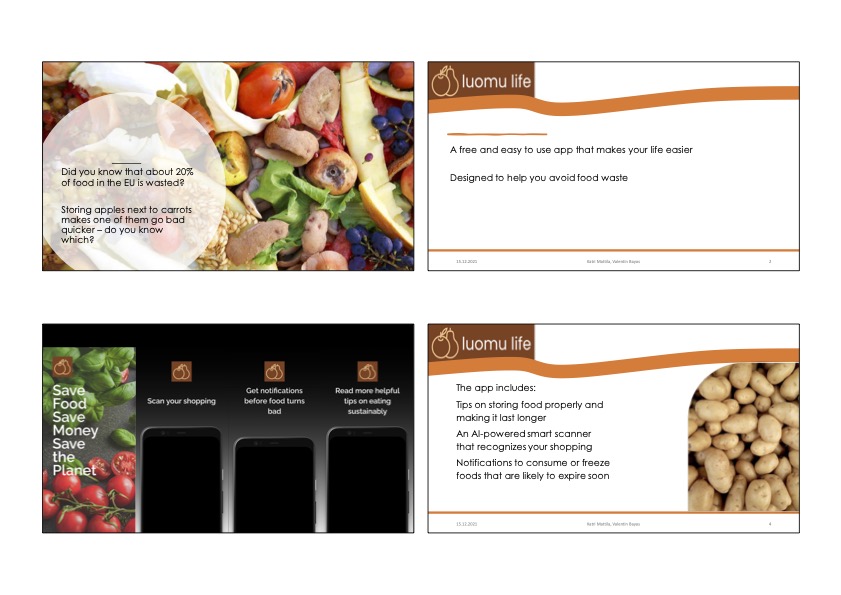
(click image to enlarge)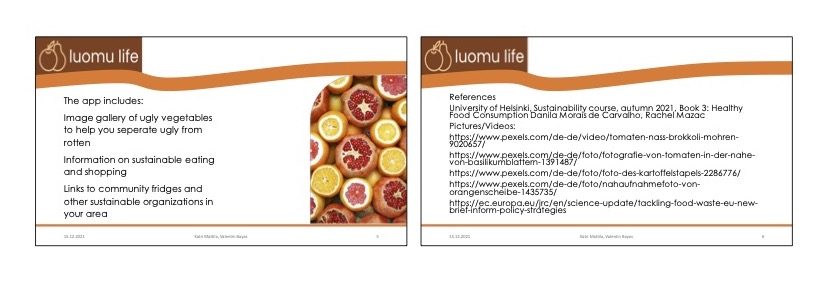
(click image to enlarge)
Other Groups (unpublished assignments)
These project assignments are not public, but if you’re a Sustainability Course (SUST-001) Autumn 2021 student, you may access them using the links below.
D01: Field Layer (Methods of regenerative agriculture)
D02: Food With Thoughts (Finding small-scale regional solutions for sustainable diets)
D04: Green Diet (Making a sustainable diet affordable)
D06: Green Riders (Replacing diesel based cold chain solutions with liquid nitrogen alternatives to lower CO2 emissions and reduce dependency on fossil fuels)
Sources:
D03
1.https://www.ipcc.ch/report/ar5/wg3/
2.:https://waterfootprint.org/en/water-footprint/product-water-footprint/water-footprint-crop-and-animal-products/
3. Burlingame, B., & Dernini, S. 2010. Sustainable Diets and Biodiversity.http://www.fao.org/docrep/016/i3004e/i3004e.pdf4. H. Guyomard, Z. Bouamra-Mechemache, V. Chatellier, L. Delaby, C. Détang-Dessendre, J.-L. Peyraud, V. Réquillart, 2021. Review: Why and how to regulate animal production and consumption: The case of the European Union, Animal, Volume 15, Supplement 1, 100283, https://doi.org/10.1016/j.animal.2021.100283.
5. Pulkkinen, H., Roininen, T., Katajajuuri, JM. et al. 2016. Development of a Climate Choice meal concept for restaurants based on carbon footprinting. Int J Life Cycle Assess 21, 621–630. https://doi.org/10.1007/s11367-015-0913-8
6. Walter Willett, Johan Rockström, Brent Loken, Marco Springmann, Tim Lang, et al. 2019. Food in the Anthropocene: the EAT–Lancet Commission on healthy diets from sustainable food systems, The Lancet, Volume 393, Issue 10170, Pages 447-492, https://doi.org/10.1016/S0140-6736(18)31788-4.
7. Huan-Niemi, E., Kaljonen, M., Knuuttila, M., Niemi, J. ., & Saarinen, M. (2020). The impacts of dietary change in Finland: food system approach. Agricultural and Food Science, 29(4), 372–382. https://doi.org/10.23986/afsci.95282
8. Hassan, L.M., Shiu, E. & Shaw, D. Who Says There is an Intention–Behaviour Gap? Assessing the Empirical Evidence of an Intention–Behaviour Gap in Ethical Consumption. J Bus Ethics136, 219–236 (2016).https://doi.org/10.1007/s10551-014-2440-0
9. STM. 2010. Developing mass catering services. Guidelines by the working group to monitor and develop mass catering services. Reports of the Ministry of Social Affairs and Health : 2010:11.http://urn.fi/URN:ISBN:978-952-00-2985-2
10. Thaler, R. & Sunstein, S. 2008. Nudge: Improving Decisions About Health, Wealth and Happiness. Yale, Yale University Press.
11. Wilson, A.L., Buckley, E., Buckley, J.D., Bogomolova, S. 2016. Nudging healthier food and beverage choices through salience and priming. Evidence from a systematic review. Food Quality and Preference 51: 47-64.
12. Sunstein, C.R. 2018. Better off, as judged by themselves: a comment on evaluating nudges. Int Rev Econ 65: 1–8.
13. Marteau, T. M., D. Ogilvie, M. Roland, M. Suhrcke, ja M. P. Kelly. 2011. ”Judging Nudging: Can Nudging Improve Population Health?” BMJ 342(jan25 3):d228–d228. doi: 10.1136/bmj.d228.
14. Vandenbroele, J., Vermeir, I. Geuens, M., Slabbinck, H. & Kerckhove, A. 2019. Nudging to get our food choices on a sustainable track. Proceedings of the Nutrition Society 79: 1-14.
15. Kaljonen, M., Salo, M., Lyytimäki, J. & Furman, E. 2020. From isolated labels and nudges to sustained tinkering : assessing long-term changes in sustainable eating at a lunch restaurant. British Food Journal 122 (11): 3313-3329.
16. Andersson, O.& Nelander, L. 2021.Nudge the Lunch: A Field Experiment Testing Menu-Primacy Effects on Lunch Choices. Games 12 (2): 1-19.
17. Marteau, T. M., D. Ogilvie, M. Roland, M. Suhrcke, ja M. P. Kelly. 2011. ”Judging Nudging: Can Nudging Improve Population Health?” BMJ 342(jan25 3):d228–d228. doi: 10.1136/bmj.d228.




